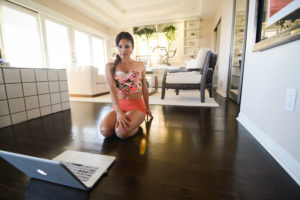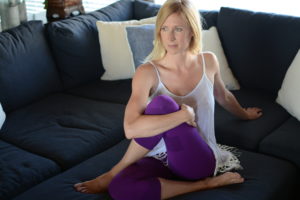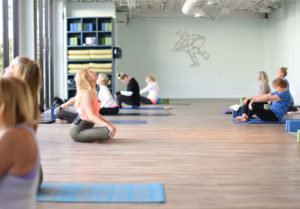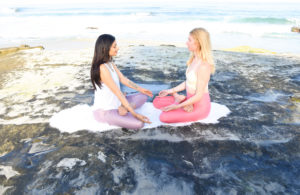It’s a great time to start a yoga practice. We have been ordered to stay at home and suddenly we have much more time on our hands. Rather than stuffing our faces and watching TV all day, take some online yoga classes! Yoga has a long list of benefits. Release stress, elevate your mood, improve posture, increase joint range of motion and develop all over functional strength. We get a lot of questions from people brand new to yoga about how to begin at home. Some people are concerned about whether or not it is safe to do yoga without the guidance of an instructor in a room. Read on for our top five tips for yoga for beginners online.
Buy a Yoga Mat and Props
 Make the investment in getting the right gear. We recommend the Manduka Pro-Lite. Yes we know it’s expensive but it will last forever. It’s thick and dense so that you will be comfortable practicing on a hard surface such as wood or tile. It is also really nice to have two blocks and a strap.
Make the investment in getting the right gear. We recommend the Manduka Pro-Lite. Yes we know it’s expensive but it will last forever. It’s thick and dense so that you will be comfortable practicing on a hard surface such as wood or tile. It is also really nice to have two blocks and a strap.
There are many poses where the floor is difficult to touch or your toes are out of reach. Put your hands on blocks to bring the floor closer to you. Wrap the strap around the ball of your foot to shorten the distance between your hands and feet. As you practice more yoga the body will gradually open. However there may be some poses where props are always needed. Blocks and a strap help to create the spaciousness that makes yoga feel so wonderful. The teacher and students in the online videos will often be using them in the class you are taking. Watch and learn. Also when you spend a little money on a new activity, you’re more likely to actually do it! Get the gear and hold yourself accountable for this wonderful new practice you’re about to embark on.
Pick Your Special Spot for Yoga for Beginners Online
 Dedicating a special space for yoga will also increase your likelihood of practicing at home.
Dedicating a special space for yoga will also increase your likelihood of practicing at home.
You don’t need much space, just enough for the length of your yoga mat. Ideally the spot is large enough that you can reach your arms out wide as well. Keep your props in a small basket or tucked away by your rolled up yoga mat when you’re finished.
Yoga at home isn’t the same as doing it in a studio. It would be great if you could find a space where you won’t be interrupted however this can be difficult. If you have small children or other people who may disrupt your practice, it’s a good idea to just accept that from the beginning. Resume your class after the interruption and know that having a toddler crawling all over you is actually a really cool way to spend time with your kids!
Make an Appointment With Yourself

Meaningful changes happen over time and are more likely to stick if you take baby steps. So to start off, choose one time per week for an online yoga class. Write it down in your calendar and stick to it as if it was an appointment that you absolutely cannot miss. Start with a 20 minute video. Try a variety of them and when you find one that feels really good, take that same class a few times before moving on to a different one. There is a feature below each video that says “add to favorites.” Create your own little library of the best classes. Yoga must be done consistently in order to reap the benefits. Three times weekly is a really good goal to move towards.
Beginner and Slow Flow is the Way to Go for Yoga for Beginners Online

Our beginner and slow flow classes are designed to be safe for yoga for beginners online. The poses and transitions are accessible and there is more instruction than in our vinyasa and buddhi flow classes. Learn how to link your movement with your breath and familiarize yourself with key alignment points. You can continue with these videos forever. There is no hierarchy and no need to move on to the more physically challenging classes. However you might find that you want to exert yourself a bit more. After you have done several of the slow flows, try a buddhi flow or a vinyasa class. We also have kundalini, which is for all levels. It incorporates meditation, chanting and breath work for a truly transformative experience.
Breath First, Everything Else Comes Second
 The breath is the most important part of your yoga practice. Always breathe through the nose in a steady, slow rhythm. If you are doing something with your body that is too much, you won’t be able to maintain yogic breathing. This is a message to slow down or take a break. Yoga is not a competition, there is no finish line and no winners. You’re “winning” if you sustain your deep nose breathing throughout an entire class. This is a great way to make sure that you don’t get injured. Pay close attention to the breath at all times. It’s a focal point that will keep you present as well as a feedback mechanism that tells you when to back off if needed.
The breath is the most important part of your yoga practice. Always breathe through the nose in a steady, slow rhythm. If you are doing something with your body that is too much, you won’t be able to maintain yogic breathing. This is a message to slow down or take a break. Yoga is not a competition, there is no finish line and no winners. You’re “winning” if you sustain your deep nose breathing throughout an entire class. This is a great way to make sure that you don’t get injured. Pay close attention to the breath at all times. It’s a focal point that will keep you present as well as a feedback mechanism that tells you when to back off if needed.
yourBuddhi founders Carolina and Amanda are here for you. Please feel free to email them any questions you have about starting a home yoga practice. We can send you links to specific classes that may suit your needs. And like with any new exercise routine, make sure you get a go ahead from your doctor if you have any injuries or other issues.

Leave a Reply
You must be logged in to post a comment.